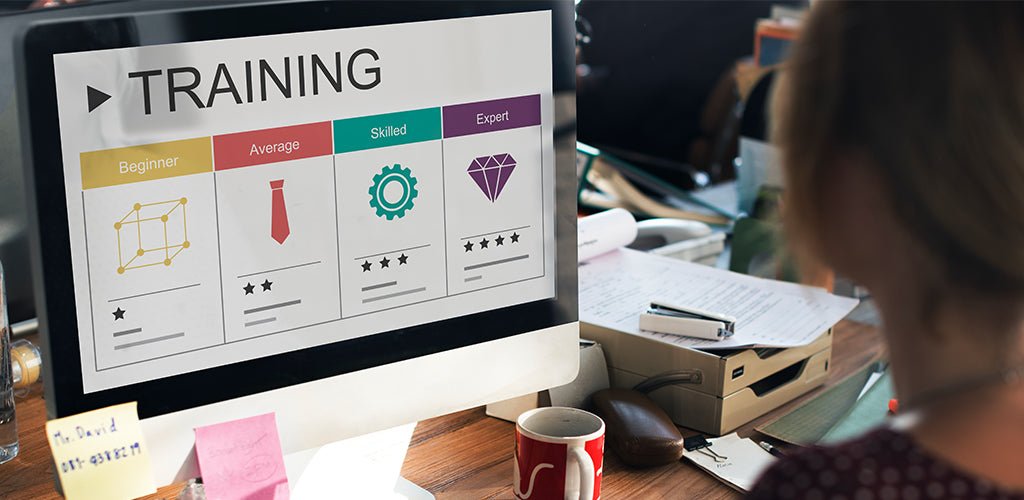Share
The Ultimate Guide to Developing Training Materials For Your Staff
Bradford R. GlaserThe effectiveness of your training program relies, in part, on how well-constructed and compelling your learning material is. The training materials you create for your staff exist to deliver valuable information to new employees, provide on-demand support to your workers, and much more.
While the success of a training program relies on the quality of the training material's content, a training program's effectiveness significantly impacts an organization's ability to thrive and grow.
For this reason, you'll want to ensure that your training material isn't something thrown together in an afternoon or composed as an afterthought. You'll find that training materials that are thorough, easy to read, and compelling will ultimately lead to higher rates of productivity, confidence, motivation, and morale among your team.
Let's look at how you can develop the best training materials for your employees to ensure they have the knowledge, skills, and resources necessary for success.

- Complete collection with 90 courses
- Downloadable, customizable programs
- 300+ hours of soft-skills training
Table of Contents
- What Are Training Materials?
- How to Develop Training Materials For Your Staff
- Identify Your Objectives
- Review Your Current Training Material
- Consider the Best Delivery Methods
- Design an Outline
- Start Writing
- Design an Assessment System
- Be Open to Feedback
- Treat It Like a Living Document
- Essential Training Material Elements
- Introduction
- Instructions
- Objectives
- Training Content
- Assessment
- Summary
- Timeline
- Help Menu
- Progress Tracker
- Additional Resources
- Taking Your Training to the Next Level
What Are Training Materials?
Training materials are an essential element of any training program. These are the content that your employees will engage with during training to achieve new skills and obtain the information they need to thrive in their position.

While the training materials of yore might have consisted of printed paper in a binder, training manuals these days can come in a wide variety of physical and digital formats. Depending on your organization's needs, you might create some combination of exercises, videos, programs, courses, workbooks, exams, or assessments to ensure that your staff has the necessary skills for their role.
How to Develop Training Materials For Your Staff

No matter how well-versed you are in the skill/task you're creating training materials for; it's a good idea to step back and identify your objectives, choose your delivery methods, and create a detailed outline before beginning to write the content.
Identify Your Objectives
Before you start writing out the content of your training materials, the first step is to clearly define your learning goals and objectives. Doing so will ensure the desired learning outcome emerges from your training material. Beyond that, it will also help to streamline the creation process by giving you a map to follow when developing the material.

There are several questions you'll want to keep in mind when determining your objectives, such as:
- What is the desired learning outcome?
- Who is your audience?
- What are the business goals the training intends to achieve?
- What gaps in skills are you trying to fill?
Once you have precise answers to these questions, you can navigate the process of creating training materials with much more agility.
Review Your Current Training Material
If you already have learning content, you'll want to look at it and see if there are opportunities to repurpose and reuse existing training material.

You might find that some of the work is already done for you, saving you priceless time and resources.
Consider the Best Delivery Methods
Training materials no longer need to be printed out and stored in binders. There are countless ways that you can deliver training materials these days, including incorporating live webinars, video series, in-person training, slide decks, and more.

You'll want to consider your audience when choosing a delivery method as well as the material you are conveying. Offering multiple delivery methods can help ensure that everyone on your staff is able to make the best use of the information you're providing.
Design an Outline
Once you have a clear sense of your objectives, have reviewed your existing material, and have chosen your delivery methods, you might be chomping at the bit to start writing your material. However, you'll want to take a step back and create a detailed outline that will simplify the writing process and help you organize the information in a straightforward and easy-to-digest way.
There's no right way to design and organize your training materials, but many businesses find that a task-based or job-based system is the most accessible to the largest number of people.

Organizing the information in this way means that your staff has a helpful reference they can turn to when they're actually on the job, as it shows each step of the process in order.
In a task-based system, each stage appears in the order it happens during the work day.
Are you wondering how much your employee training program is going to cost? You can learn about the average cost of staff training programs in this article.
Start Writing
Now you've reached the point where you're ready to start writing. It can be helpful to separate the production from the editing stages, meaning, at first, you can write down everything you think that seems relevant.
That allows you to freely introduce information to the manual without having to question every little decision. Once it's time to edit, though, you'll want to eliminate any excessive information or details that make a task appear more complicated.

The goal should be that your staff can quickly and easily find the content they are looking for and understand it.
Design an Assessment System
Once you have begun using your training materials, you will want to know whether they are as effective as possible. To achieve this, you'll want to give out assessments after your training session.
Before you design your system for assessment, you'll want to step back and consider what a successful assessment would look like for your company. Would you quiz your employees on the information in the manual, or would you want to track their progression by witnessing their skills on the job? Maybe a question-and-answer session after the fact would suffice, or perhaps you'll decide to give them a multiple-choice test.

Designing your assessment system alongside your training materials can be very useful. When you have a clear sense of what success would look like, you can look at your training materials and ensure that they are designed to allow your employees to know exactly what to do in each possible scenario in their position.
As a part of your assessment system, you will also want to keep an eye on employee engagement and motivation during the training. You might find that some staff members feel that the training is unnecessary considering their existing skills or a distraction from their primary responsibilities. Take a look at this guide for more information about how to keep employees engaged and motivated during training.
Be Open to Feedback
Feedback is a genuinely priceless resource during the process of creating training materials for your staff. This is particularly true if you are highly knowledgeable in the tasks and skills being explained as a part of the training. Sometimes, when you are truly an expert on a topic, it can be hard to step back and explain it to people that are entirely unfamiliar with the subject.
For this reason, it's a great idea to talk to your colleagues and your staff to find out where improvements could be made to the training material. After you've reviewed the training materials, ask your employees if any sections they felt were unclear or could be improved upon.

It can feel frustrating to receive negative feedback after you've put so much time and energy into developing training materials. However, the ultimate goal of these materials is to ensure that your business runs smoothly and efficiently, so any criticisms that lead to change towards these ends must ultimately be viewed as positive.
Are you ready to start brainstorming ideas for collecting employee feedback? Check out this guide on how to gather feedback from your staff both during and after training.
Treat It Like a Living Document
If you want your staff to rely on the training materials you've made as they acclimate to their new position, it's essential to be accurate and up-to-date. If your employees find contradictory information between the materials and how things work on the ground, they will lose trust in the authority of the materials.

That can create confusion, lost time, and a general reduction in morale as employees feel they don't have a clear understanding of what is expected of them and what processes they should follow when completing tasks.
Essential Training Material Elements
Now, let's look at some of the key elements you'll want to include in your training materials.

You likely have a wealth of knowledge on the topic at hand when creating your manual, but you'll want to ensure that only the most essential information is included. This way, your staff can focus on the most vital points without getting lost in the details.
Introduction
Your training materials should have an introductory section that gives a brief overview of the topics covered in the manual.

It's crucial that this part of the manual is written in an easy-to-understand way, even if the materials themselves get quite technical later on. This is an opportunity to pique the interest of your staff and give them a general sense of what the training will consist of.
Instructions
Next, you'll want to give an explanation about how employees can best use the training materials.

That helps them to better navigate the manual both during training and independently.
Objectives
Another section to include is one entitled Objectives, Goals, and Targets.

Here, you can communicate to your staff the purpose and intended outcome of the training session.
Training Content
Of course, the core of your training manual will be the actual content itself.

This material could include slides, videos, images, written instructions, courses, and more.
Assessment
After the content section of the manual, you'll also want to include assessments that help you determine how effective the training has been.

You can include surveys to learn how to improve the manual and quizzes to determine whether the manual taught your staff the skills and knowledge they need to know to do an effective job.
Summary
Particularly with lengthy training materials, including a summary at the end that goes over the most important points made in the content can be helpful. This is a great way to help people remember what they learned during the training.

Additionally, you can also include follow-up steps that point your staff toward helpful resources.
Timeline
Including a timeline in your training materials helps your staff understand the bigger picture of the training program.

By being able to track their movement through the training, they can have a clear sense of how much further they have to go and whether they're on track.
Help Menu
No matter how thorough and well-designed your training materials are, there will always be some questions that aren't addressed in your manual or some staff members needing extra help.

Having a way for employees to seek additional answers to their questions or concerns ensures that everyone can move forward with the necessary information as quickly as possible.
Progress Tracker
If your staff members are working on their training independently, it can be helpful to include a progress tracker that they can use to understand where they are in the program.
![]()
This is an excellent tool for allowing them to strategically plan their time while ensuring they finish the program by a stated deadline.
Additional Resources
Finally, you'll also want to ensure that there is a section in your manual that includes links to supplementary materials that your staff can refer to.

That might consist of relevant articles, e-books, courses, and more that employees can use when looking for more information or working to answer a looming question.
Taking Your Training to the Next Level
It's worth investing time into creating the best possible training resources for your staff, as it ensures that any new employees or processes start on the right foot.
At HRDQ, we offer a collection of downloadable and customizable courses that can be used for virtual and classroom instructor-led training and self-study learning.

The complete collection contains more than ninety programs on team building, leadership, conflict, communication, and many other subjects. With more than three hundred hours of soft-skills training and materials for facilitators and participants, this is a one-stop shop for your training material needs.
If you're looking for customizable training material that will help you take your employee training to the next level, take a look at our Reproducible Training Library Complete Collection.
Do you have any questions regarding training materials, how to develop training materials, or anything similar? If so, you are always more than free to leave us a comment down below, and we'll ensure we get back to you within a day or two! We do our best to reply to every comment and question we receive, and we'd be more than happy to help however we can.

- Complete collection with 90 courses
- Downloadable, customizable programs
- 300+ hours of soft-skills training





















































